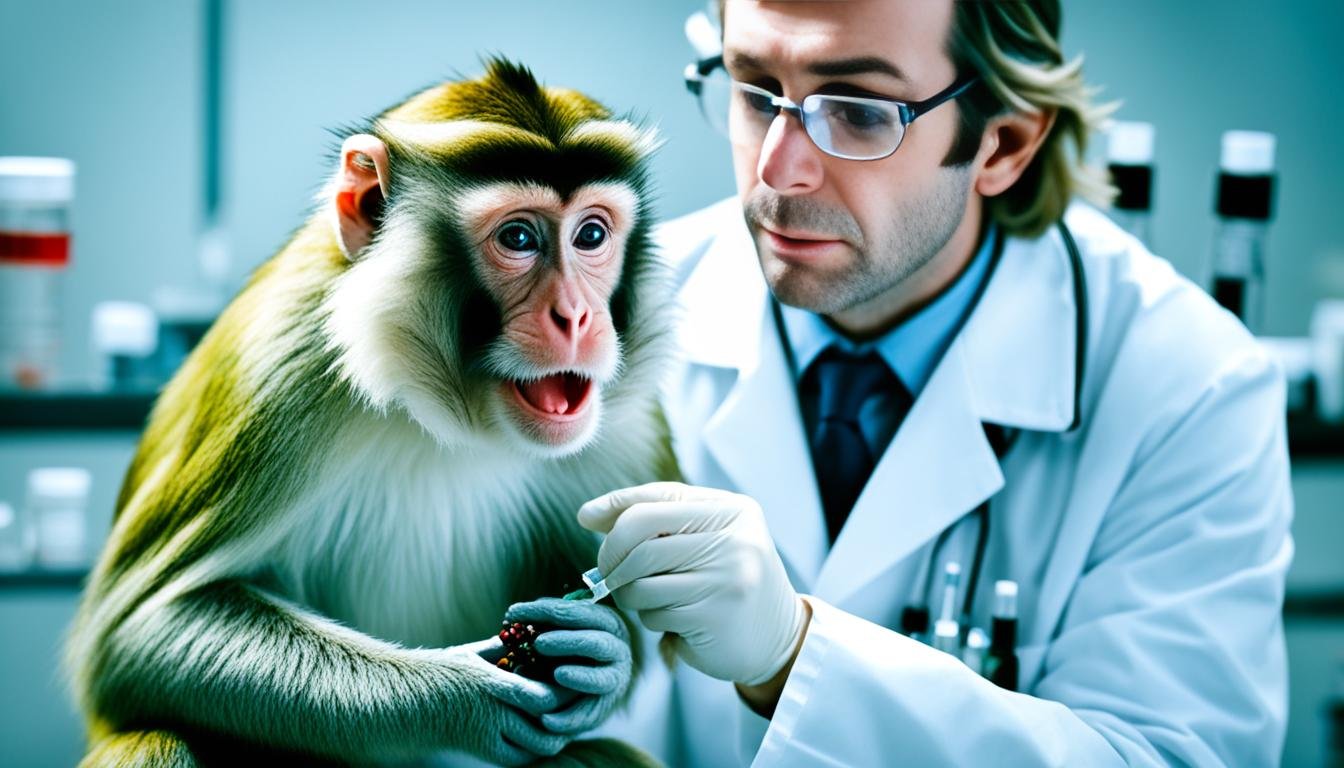Monkeypox: Symptoms and Treatment
Did you know that mpox, also known as monkeypox, can last 2 to 4 weeks? It has a unique set of symptoms like a painful rash, fever, and swollen lymph nodes. As outbreaks spread worldwide, knowing about this virus is key. Spotting the early signs of monkeypox can help in treatment and slow its spread.
This article will cover the monkeypox symptoms and treatment options. The mpox virus is worrying because it spreads through touch. So, being aware and taking steps to prevent it is crucial for everyone. We’ll look into the mpox rash and other symptoms to help you know how to deal with this virus.
Key Takeaways
- Monkeypox symptoms can begin 3 to 17 days after exposure and typically last 2-4 weeks.
- The mpox rash often appears on the face, hands, or feet before spreading to other areas.
- Transmission occurs through direct contact with infected individuals or animals and contaminated objects.
- Preventive measures include good hygiene practices and avoiding close contact with infected individuals.
- Treatment focuses on alleviating symptoms, often employing antiviral drugs used for smallpox.
- Complications can arise, especially in vulnerable populations such as children and pregnant individuals.
Introduction to Monkeypox Virus
The mpox virus is an orthopoxvirus, similar to smallpox. It was first found in 1958 in lab monkeys. Since then, it has spread more, especially in Central and West Africa.
There’s been a big rise in monkeypox overview lately. This is because smallpox was wiped out, and vaccination efforts dropped. Now, animals and people are more at risk. The Democratic Republic of Congo is a key area where this virus is often found.
Recent outbreaks show how monkeypox spreads, mainly among certain groups. The 2022 outbreak mostly hit men who have sex with men (MSM). Health groups are teaching people about how the virus spreads. It can move from animals to humans or from person to person.
In short, the mpox virus is a big worry for public health. We need to spread the word and take steps to stop it from spreading more.
Understanding the Monkeypox Disease
Monkeypox is a disease caused by the monkeypox virus, mainly found in Central and West Africa. Knowing about the monkeypox virus helps us understand its effects, symptoms, and how it spreads. It’s similar to smallpox but usually less severe.
The disease can spread from animals to humans and from person to person. Recently, monkeypox has become more common worldwide, making people more aware of it and how to handle it.
What is the Monkeypox Virus?
The monkeypox virus was first found in 1958 in monkeys. It was first seen in humans in 1970 in the Democratic Republic of the Congo. There are two types of the virus, with one being more serious and deadly.
People may feel feverish and have muscle pain during the three to 21-day wait before symptoms show. These symptoms can then turn into a rash.
Key Differences with Other Viral Infections
Knowing how monkeypox is different from other infections is key to handling it well. It’s not as contagious as chickenpox and its rash lasts longer. It can be hard to tell apart from smallpox, which makes things tricky.
It’s important to know the differences between monkeypox and smallpox, especially since monkeypox can be serious for some people. This includes young kids and those with weak immune systems.
| Characteristic | Monkeypox | Smallpox |
|---|---|---|
| Transmission | Contact with infected individuals or animals | Airborne and direct contact |
| Incubation Period | 3 to 21 days | 7 to 17 days |
| Severity | Milder, though can be severe | More severe cases typically |
| Fatality Rate | 0.1% to 10% | 30% |
| Symptoms | Fever, rash, lymphadenopathy | Fever, rash, body aches |
Monkeypox: Symptoms and Treatment
Knowing the symptoms of monkeypox is key to handling it well. Symptoms start to show 1 to 21 days after getting the virus. They include fever, muscle aches, headaches, fatigue, and swollen lymph nodes. These symptoms come before the rash shows up.
Common Symptoms of Monkeypox
At first, monkeypox may feel like the flu, with symptoms like:
- Fever
- Headaches
- Back pain
- Aches and pains in the body
- Fatigue
- Swollen lymph nodes
These signs make it easier to spot the disease early, helping with quick medical help.
The Progression of the Rash
About 1 to 3 days after the fever starts, the rash of monkeypox shows up. Knowing how the rash changes is key for doctors to diagnose. The rash goes through different stages for about 2 to 4 weeks:
- Macules – flat lesions that develop on the skin
- Papules – raised bumps that appear
- Vesicles – fluid-filled blisters that form
- Crusts – the lesions eventually crust over and heal
Watching how the rash changes helps doctors know what treatment is needed and when the virus is contagious.
Complications That May Arise
Monkeypox can lead to different complications. Some possible issues include:
- Bacterial infections of the skin – secondary infections may occur as a result of scratching or open sores
- Respiratory issues – severe cases can affect breathing
- Eye infections – leading to potential vision problems
People with weak immune systems and kids are more at risk for serious problems. Catching and treating these issues early can help them get better faster and lower the risk of death.
Monkeypox Transmission
It’s important to know how monkeypox spreads to control its spread. The main ways it spreads are from person to person and from animals to humans. Learning about these ways helps us take steps to prevent it.
How Monkeypox Spreads Between Individuals
Mpox spreads mainly through close contact with infected areas, fluids, and droplets. You can get it by:
- Intimate contact, including sexual activities
- Skin-to-skin interactions with infected areas
- Sharing personal items like towels or bedding
- Contact with respiratory secretions from an infected person
The virus is contagious from when symptoms start until the rash heals. Some studies suggest it can spread even before symptoms show. Knowing this helps us prevent it better.
Animal-to-Human Transmission
Monkeypox can also spread from animals to humans, especially in areas where it’s common. This can happen through:
- Bites or scratches from infected animals
- Contact with contaminated waste or materials
- Handling or eating infected animals, like during hunting or trapping
- Close contact with infected pets
Being careful around animals is key. Some activities increase your chance of getting monkeypox. If you’re in or visiting areas where it’s common, be careful to avoid wild animals and protect yourself.
Monkeypox Diagnosis
Early diagnosis is key to managing monkeypox well. The process starts with recognizing monkeypox symptoms, like fever, rash, and swollen lymph nodes. Spotting these symptoms early helps people get medical help fast, reducing the spread of the virus and improving health outcomes.
Doctors use both clinical checks and lab tests to confirm the virus’s presence.
Identifying Symptoms for Early Diagnosis
Knowing the symptoms is vital for early diagnosis. Look out for:
- Fever and chills
- Fatigue
- Headache
- Muscle aches
- Swollen lymph nodes
- Rash that progresses over time
If you notice these signs, see a doctor right away. Quick action helps manage the disease better and stops it from spreading.
Laboratory Testing Procedures
Monkeypox laboratory testing is crucial for accurate diagnosis. Using mpox PCR testing, doctors can check for the virus in lesion samples. This test is key in telling monkeypox apart from other infections, especially since different strains have different outcomes.
Quick lab tests help in a strong health response. They ensure people get the right care and stop the virus from spreading further.
https://www.youtube.com/watch?v=CYdYnMmmcWc
Monkeypox Prevention Strategies
Preventing monkeypox means taking many steps. It’s important to avoid close contact with those who are sick, keep clean, and know about outbreaks. These steps help stop monkeypox and reduce the chance of spreading it.
Practices to Avoid Infection
- Regular hand washing with soap and water, or using hand sanitizer when soap is not available.
- Avoiding direct contact with individuals displaying monkeypox symptoms.
- Wearing masks in crowded places to decrease potential exposure.
- Staying informed about ongoing outbreaks to adjust prevention methods accordingly.
- Practicing safe handling and consumption of animals that may harbor the virus.
Importance of Vaccination
Vaccination is key in preventing monkeypox. It’s especially important for those at high risk, like healthcare workers and people with many sexual partners. Vaccines work well and give a good level of protection.
Studies show that people who got the smallpox vaccine have about 80% protection against MPXV. This is because the viruses are similar.
Health experts say getting vaccinated quickly after being exposed to the virus is crucial. This can greatly reduce the risk of getting monkeypox if done in time.
Monkeypox Vaccine and Treatment Options
It’s important to know about monkeypox vaccines and treatments. Vaccines made for smallpox work well against monkeypox, especially during outbreaks. There are many ways to treat symptoms and help people get better.
Availability of Vaccines and Therapeutics
The main vaccine for monkeypox comes in two doses, spaced four weeks apart. After the second dose, you’re fully protected about two weeks later. The JYNNEOS vaccine is key for preventing monkeypox, especially for those at high risk like pregnant people.
The ACAM2000 vaccine also works for some, but not for pregnant women because it’s not safe. For treating mpox, tecovirimat is often the first choice for those needing more than just basic care. Other treatments include cidofovir and brincidofovir.
Brincidofovir is FDA-approved for smallpox but its effect on monkeypox is still being studied. Many patients needing it are very sick and might get tecovirimat and cidofovir together. Cidofovir is approved for a different virus but might help with severe monkeypox cases. VIGIV is used for vaccinia vaccine issues, not monkeypox.
Best Practices for Home Care
If you have monkeypox, taking care of yourself at home is key. Staying away from others is important to stop the virus from spreading. Keeping your lesions clean and covered helps lower the chance of passing it on.
- Follow advice on managing symptoms, like using pain relievers like acetaminophen or ibuprofen.
- Provide supportive care, which might include rest and home remedies.
- Watch how your symptoms change to see if you need to see a doctor.
Looking after someone with mpox means knowing how to do it right. If you’re unsure about symptoms or treatments, talk to health experts. This is especially true for those with serious health issues like HIV.
Recent Monkeypox Outbreaks
The recent rise in monkeypox cases has caught the eye of health experts around the world. This increase has led to a shift, with cases showing up in areas not usually affected. It’s important to understand these mpox global trends to know how to respond.
Overview of Global Trends
Since 2022, monkeypox has become a big concern. By April 2023, there were over 87,000 confirmed cases worldwide. Most of these cases were in Europe, mainly affecting men who have sex with men.
This has led to a focus on surveillance and studies to grasp the situation better. The recent monkeypox outbreaks have pushed for better monitoring and research.
Response Measures Taken by Health Authorities
Health authorities have taken steps to fight the growing threat of monkeypox. Vaccines and awareness campaigns have been key in mpox outbreak management. Working together, health groups and local health departments have been crucial in controlling the spread.
The goal is to find a unified way to stop the virus and protect those at risk.
| Country | Confirmed Cases (Until June 2022) | First Reported Case |
|---|---|---|
| United Kingdom | 71 | May 20, 2022 |
| Portugal | 14 | May 18, 2022 |
| Spain | 7 | May 18, 2022 |
| Canada | 13 | May 18, 2022 |
| United States | 49 (17 states) | June 10, 2022 |
| Democratic Republic of Congo | Major outbreaks reported | 1970 |
Current Research on Monkeypox
Research is key to understanding monkeypox. Scientists are looking into how it spreads, its symptoms, and how vaccines work. They aim to learn more about the virus to fight it better.
What Scientists Are Learning
Studies show that monkeypox can spread without symptoms. Researchers are tracing how this happens. This is crucial for making better health plans.
They want to know when and where outbreaks happen. This info can help lower the number of cases.
Future Directions in Vaccine Development
The future looks bright for monkeypox vaccines. Researchers are working on making vaccines like JYNNEOSTM better. They aim to protect against more viruses, keeping people safer.
| Research Focus | Description | Potential Impact |
|---|---|---|
| Transmission Dynamics | Studying how monkeypox spreads in various populations | Improved public health strategies and reduced transmission rates |
| Vaccine Efficacy | Evaluating the effectiveness of current vaccines | Informed vaccine policy and potential new vaccine development |
| Asymptomatic Spread | Identifying conditions under which asymptomatic transmission occurs | Enhanced understanding leading to more effective control measures |
Conclusion
Monkeypox is a big health challenge for us all. Knowing its symptoms, how it spreads, and how to treat it is key. We need strong health responses and community help, especially for those at higher risk like men who have sex with men.
Vaccines like Jynneos and treatments like tecovirimat and brincidofovir are important. Most people get mild symptoms, but quick action and treatment help a lot. We need an informed public to fight this health crisis.
As we learn more, using vaccines and treatments well will be crucial. Communities and health experts must stay alert. Early detection and quick action are key to stopping monkeypox and keeping everyone healthy.
FAQ
What are the common symptoms of monkeypox?
How does monkeypox spread?
How is monkeypox diagnosed?
What treatments are available for monkeypox?
Is there a vaccine for monkeypox?
What complications can arise from monkeypox?
How long do monkeypox symptoms last?
What preventative measures can be taken against monkeypox?
What is the significance of ongoing research on monkeypox?
Source Links
- Mpox (monkeypox)
- What is mpox, previously called monkeypox, how does it spread and how can it be prevented?
- Mpox (Monkeypox) – StatPearls – NCBI Bookshelf
- Treatment and prevention of monkeypox
- Factsheet for health professionals on mpox (monkeypox)
- About Mpox | Mpox | Poxvirus
- Mpox
- Mpox (monkeypox)
- Mpox: Department of Health
- Mpox: Symptoms, getting tested, what to do if you have mpox or were exposed
- Monkeypox – Symptoms and Prevention
- Monkeypox: Symptoms, Transmission and Treatment
- How It Spreads | Mpox | Poxvirus
- Monkeypox: A Review of Clinical Features, Diagnosis, and Treatment
- What Is Monkeypox: Symptoms, Pictures, and Treatment
- Prevention and Treatment of Monkeypox
- Prevention and Treatment of Monkeypox: A Step-by-Step Guide for Healthcare Professionals and General Population
- Monkeypox
- Mpox Treatment Information for Healthcare Professionals | Mpox | Poxvirus
- Monkeypox – Los Angeles, CA
- Challenges in the treatment and prevention of monkeypox infection; A comprehensive review
- Prevention and Treatment of Monkeypox
- Interim Guidance for the Prevention and Treatment of Monkeypox…
- Reemergence of Monkeypox: Prevalence, Diagnostics, and Countermeasures







